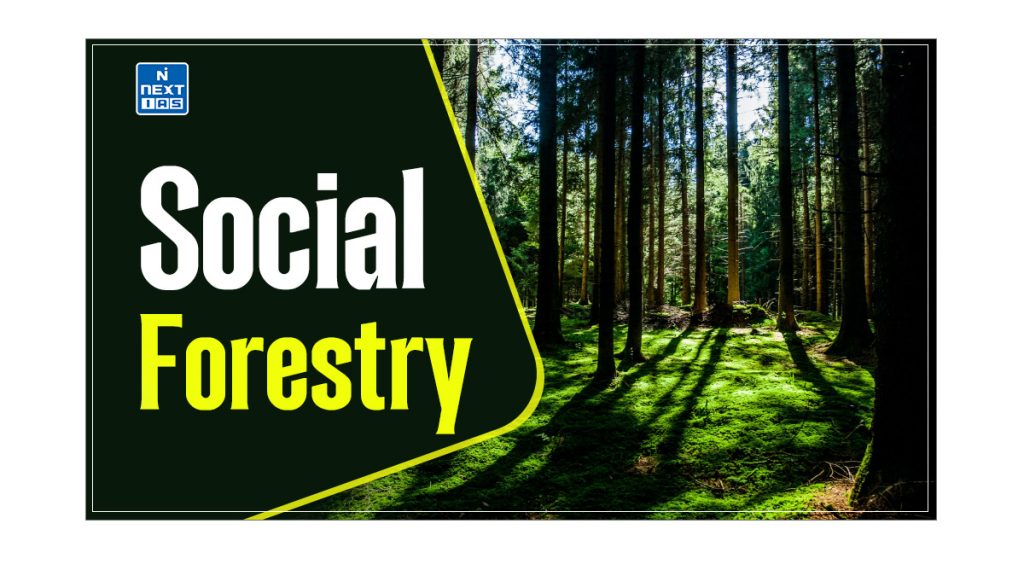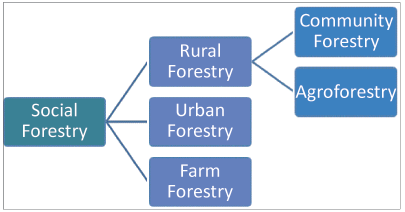
Social Forestry has emerged as a promising solution to the challenges of environmental degradation as well as rural poverty. By empowering local communities and promoting sustainable forest management, it has contributed significantly to building a greener and more equitable future. This article aims to study in detail the concept of Social Forestry, its meaning, objectives, types, benefits, challenges and other related aspects.
What is Social Forestry?
- Social forestry means “management and protection of the forests as well as afforestation of barren lands aimed at helping in environmental, social and rural development as against the traditional objective of securing revenue”.
- It is the afforestation of all lands other than croplands that are available outside forest areas with the purpose of meeting the ecological and environmental security requirements and day-to-day needs of the rural population.
- Its main objective is to create forests on any available lands that are not being used for other purposes so as to reduce pressure on traditional forests.
- Thus, it can also be described as “forestry of the people by the people and for the people”.
| – The term social forestry was first used in 1976 by the National Commission on Agriculture. – Its significance has been emphasised in the National Forest Policy of 1952 and 1988. |
Key Objectives of Social Forestry
Its key objectives include:
- Environmental Conservation: It aims to contribute to the conservation of biodiversity, soil conservation, and watershed management.
- Sustainable Resource Use: It also seeks to promote sustainable use of forest resources to ensure long-term environmental health and productivity.
- Community Empowerment: Involving local communities in decision-making processes related to forest management has the effect of empowering them.
- Livelihood Improvement: By giving the rural population access to forest resources and associated benefits, it seeks to enhance their socio-economic conditions.
Types of Social Forestry
As per the National Commission on Agriculture, there are three types of Social Forestry:
- Urban Forestry,
- Rural Forestry, and
- Farm Forestry

Each of them is discussed in detail in the sections that follow.
Urban Forestry
It refers to raising and management of trees on public and privately owned lands in and around urban centres such as greenbelt parks, roadsides along Industrial and commercial green belts etc.
Rural Forestry
- Rural forestry is a broad term encompassing various forestry practices aimed at meeting the needs of rural communities.
- It involves the management and protection of forests, as well as the planting of trees on non-forest lands.
- There are two broad types of Rural Forestry – Agroforestry and Community Forestry.
Agroforestry
- Agro-forestry refers to a simultaneous process that involves the raising of trees and the growing of agricultural crops on the same land.
- The waste patches can also be included.
- It combines forestry with agriculture, thus altering and modifying the simultaneous production of food, fodder, fuel, timber and fruit.
Difference Between Social Forestry and Agroforestry
Though agroforestry is a type of social forestry, the two differs in the following respects:
| Agroforestry | Social Forestry |
|---|---|
| Agroforestry combines the production of agriculture, crops and fodder species with the forest and forest plants simultaneously or sequentially on the same land units. | It includes forest crops, including food, fodder, fuel wood, and small timber, to meet society’s multifarious demands. |
| It is a different package of technology that has to be developed before implementation. | It has no such requirements, and fallow lands are utilised to raise forest crops. |
| There is a close crop relationship whose cultivation is determined by the demands of the region, the demands of the person, etc. | Forest crops are raised either independently or in combination with other forest crops, including legumes and grasses. This does not require such deep research on the interrelationships. |
| Guided generally by economic consideration after considering the combined yield of trees and agricultural crops. | Social demands and requirements are more important than any other economic conservation. |
| It is done on dry lands, waterlogged, alkaline, and saline soils, and nearly all cultivable areas and forest blocks. | It is practised around field bunds, palm ponds, unproductive land and village common land. |
Community Forestry
- Community Forestry involves the raising of trees on community or public land such as the village pasture and temple land, roadside, Canal Bank etc.
- It aims to provide benefits to the community as a whole.
- Community Forestry provides a way to landless people to associate themselves with tree raising and thus get those benefits that otherwise are restricted for landowners.

Farm Forestry
- Farm Forestry refers to the process under which farmers grow trees for commercial and noncommercial purposes on their farmland.
- Forest departments of various States distribute tree-seedlings free of cost to small and medium farmers.

Benefits of Social Forestry

Economic Benefits
- It creates opportunities for income generation through the sustainable harvesting of timber, non-timber forest products (NTFPs), and eco-tourism.
- It also provides employment opportunities in forest management and conservation activities.
Environmental Benefits
- By promoting sustainable forest management practices, it contributes to the preservation of biodiversity, prevention of soil erosion, and regulation of water cycles.
- Forests managed through these activities also play a crucial role in carbon sequestration, helping to mitigate climate change.
Social Benefits
- Involving communities in forest management fosters a sense of ownership and responsibility, leading to better protection and management of forest resources.
- It also enhances social cohesion and community development by creating opportunities for collective action and decision-making.
Challenges & Limitations of Social Forestry
- Institutional and Policy Issues: Inadequate policy support, lack of legal recognition of community rights, and insufficient capacity-building often hinder effective implementation.
- Conflicts and Coordination Issues: Lack of an effective coordination mechanism may result in conflicts between local communities and other stakeholders, such as government agencies or private sector entities.
- Resource Constraints: Limited financial and technical resources can impact the scale and effectiveness of initiatives.
- Monitoring and Evaluation: Regular monitoring and evaluation of the projects require robust data collection and analysis mechanisms, which may be lacking in some areas.
Conclusion
Social Forestry represents a holistic approach to forest management that integrates environmental, economic, and social dimensions. By involving local communities in the stewardship of forest resources, it not only enhances forest conservation but also contributes to sustainable development and improved livelihoods. Addressing its challenges and leveraging its benefits can lead to more resilient and thriving ecosystems, as well as stronger and more empowered communities.
GS - 1 GS - 3




